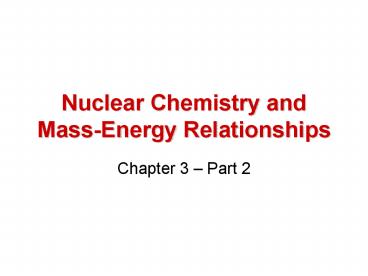Nuclear Chemistry and Mass-Energy Relationships
Title:
Nuclear Chemistry and Mass-Energy Relationships
Description:
Nuclear Chemistry and Mass-Energy Relationships Chapter 3 Part 2 Mass Excess or Mass Defect = M A = nuclidic mass mass number Example Calculate mass ... –
Number of Views:69
Avg rating:3.0/5.0
Title: Nuclear Chemistry and Mass-Energy Relationships
1
Nuclear Chemistry and Mass-Energy Relationships
- Chapter 3 Part 2
2
Mass Excess or Mass Defect
- ? M A nuclidic mass mass number
- Example
- Calculate mass excess in MeV for 14C. The
nuclidic mass of 14C is 14.00324 daltons. - ? M A 14.00324 14 3.24 x 10-3 daltons
3.24 x 10-3 daltons x 931.5 MeV/dalton 3.02
MeV
3
Energy Changes in Nuclear Reactions
- Q-value
- Q (Smassesreactants-Smassesproducts) x 931.5
MeV/daltons - Q S ?reactants - S ?products
- Q-value calculator http//www.nndc.bnl.gov/qcalc/
- Atomic Mass Data Centerhttp//www.nndc.bnl.gov/am
dc/
4
Q-value
Energy released in a nuclear reaction (gt 0 if
energy is released, lt 0 if energy is used)
Example The sun is powered by the fusion of
hydrogen into helium
4p ? 4He 2 e 2ne
Mass difference dMreleased as energydE dM x c2
5
Binding Energy
- E (MeV) Masses of reactants Masses of
products) 931.5 MeV/dalton
BE Zmp Nmn m(AX) Zmec2 if
using atomic masses -
BE ZmH Nmn m(AX)c2
(Remember 1 u 1 dalton 931.5 MeV/c2
6
Binding Energy
Energy that is released when a nucleus is
assembled from neutrons and protons
mp proton mass, mn neutron mass, m(Z,N)
mass of nucleus with Z,N
- B 0 for H, otherwise B gt 0
- 2D1 - deteriumBE (1.007825 1.008665 -
2.0141) x 931.481 MeV 2.226 MeV - 4He2BE (21.007825 21.008665 - 4.002603) x
931.481 MeV 28.30 MeV - 238U146BE (921.007825 1461.008665 -
238.0289) x 931.481 MeV 1822.06 MeV
The more nucleons packed into a nucleus, the more
energy is released, and thus the higher the
binding energy.
7
Binding Energy per Nucleon
Source http//hyperphysics.phy-astr.gsu.edu/
8
Energy Changes in Radioactive Decay
- Alpha Decay
- 252Cf ? 248Cm a
- Q ?Cf (?Cm ?a) 76.030 (2.424 67.388)
6.22 MeV
9
Energy Changes in Radioactive Decay
- Negatron Decay
- 32P ? 32S e- antineutrino Q
- Q ?P- ?S -24.305 (-26.016) 1.711 MeV
- Positron Decay
- 26Al ? 26Mg e atomic electron neutrino Q
- Q ?(26Al) ?(26Mg) 2me
- -12.210 (- 16.214 2(0.511)) 2.982 MeV
10
Closed-Cycle Decay for Mass-Energy Calculations
- QPu?U QU?Np QPu ? Am QAm ?Np
- QU?Np QPu ? Am QAm ?Np- QPu?U
- QU?Np 0.0208 5.49 -4.90 0.61 MeV
11
Semiempirical Binding Energy Equation
- a) Volume
- BE/A 8 MeV, so BE 8A or BE ? A
- ? avA
- b) Surface
- nuclei on surface have fewer neighbors volume
term will over-estimate BE - surface area of sphere 4pR2
- so ? R2
- ? (r0A1/3)2
- ? A2/3
- asA2/3
- c) Coulomb
- Coulomb repulsion of protons each proton
repels all others - Z protons repelling (Z 1) protons
- estimate using Coulomb energy for a sphere
Collect constants into one ac 0.72 MeV
acZ(Z-1)A-1/3
12
Semiempirical Binding Energy Equation
- d) Symmetry
- Light stable nuclei have NZ, heavy nuclei have
NgtZ - Too many protons, unstable too many neutrons,
unstable - asym(A - 2Z)2/A
- e) Pairing
- Preferred BE for even Z, N
- Pairing energy d
- d apA-3/4 even Z and even N
- d 0 odd Z, even N OR even
Z, odd N - d -apA-3/4 odd Z and odd N
13
Binding Energy
Best fit values (from A.H. Wapstra, Handbuch der
Physik 38 (1958) 1)
aV aS aC aA aP
15.85 18.34 0.71 92.86 11.46
in MeV/c2
14
Nuclear Energy Surface Diagram
For a constant A
Binding energy per nucleon along const A due to
asymmetry term in mass formula
2d-displacement
valley of stability
(Bertulani Schechter)































